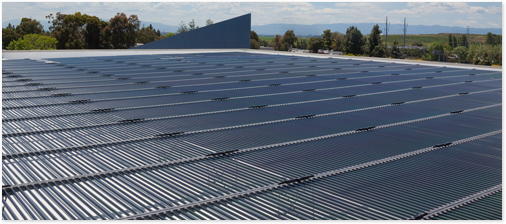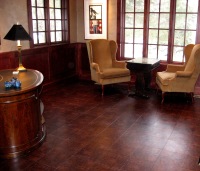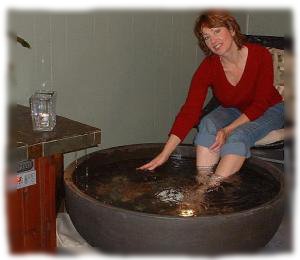Our team has now reexamined Eleek's offerings, and I have added an editor's note to the top of this post to reflect that, and written more about Eleek here:
http://www.buildinggreen.com/live/index.cfm/2012/3/13/Eleek-Lighting-Tha...
Blog Post

Editor's note: Since the original posting of this blog, we have revised our opinion of Eleek, and written more about its cast aluminum hardware, leading us to remove mention of it from this post. We apologize to Eleek and its owners for misunderstanding their offerings. We'll also be taking a second look at IdeaPaint, which is now available from CRE-8 in a lower-VOC version.
At GreenSpec, we most often like to talk about our 2,200-plus listings of exemplary green products--listings from over 1,600 companies representing thousands of individual products. For ten years we have annually highlighted our Top-10 products of the year, for example.
Today we look at six products we rejected from GreenSpec, and why. There are plenty of products that simply aren't efficient, low-emitting, or otherwise sustainable enough for our standards, but here we've selected some products that have a lot going for them, but also have some serious flaws.
We hope that pointing out flaws can lead to product and industry change. EcoDomo's recycled leather tiles for flooring and walls are made from recycled leather scraps mixed with natural rubber and a binder made from Acacia bark. We originally rejected the tiles in 2006 because of concerns about chromium, a toxic heavy metal used in leather tanning. EcoDomo took our concerns seriously, and now their tiles are chromium-free and listed in GreenSpec.
BuildingGreen relies on our premium members, not on advertisers. Help make our work possible.
See membership options »
What it is: Solyndra's roof-mounted solar PV technology is based on a glass tube lined with thin-film copper indium gallium selenide (CIGS). The theory is light can hit the tubes at any angle and that the tubes capture light bouncing back off the roof to improve performance.
Why we rejected it: We hate to kick Solyndra while it's down--and its high-profile bankruptcy has earned Solyndra a lot of derision--but we had technical concerns about Solyndra a while back when we researched the product for GreenSpec. Solyndra wouldn't provide data backing up the captured light bouncing off the roof. Perhaps more damning to the company's fortunes, Solyndra took an inexpensive thin-film PV product and wrapped it in an expensive manufacturing process, with fragile tubes that were a challenge to transport. The company claimed low installation costs would make them more than competitive, but we saw it as a gimmick that didn't deserve to be included in GreenSpec.
What it is: Green Polyurethane from Nanotech Industries International, Inc. is a hybrid polyurethane that uses a proprietary combination of epoxy and polyurethane technologies that, according to the company, creates a surface that has better adhesion, three to four times the corrosion resistance, and 50% more chemical resistance than conventional polyurethanes. And it does so without solvents, VOCs, or the use of isocyanates.
Why we rejected it: After digging into the MSDS, we found that the product uses bisphenol-A (BPA), a main ingredient in epoxies. While GreenSpec encourages the development of isocyanate-free polyurethanes (we list isocyanate-free whey-protein polyurethanes for wood applications, for example), but we are not convinced that using epoxy is the best substitute. Few epoxy-based materials make it into GreenSpec due to the BPA concerns.
What it is: CRE-8 is a water-based paint that transforms any surface into a dry erase board. Says the manufacturer: "Transform a child's bedroom or playroom into a place to explore and express their creativity and imagination. Paint a toy box and make it more entertaining than everything inside of it. IdeaPaint creates the perfect spot for the family to interact and keep up with each other's busy lives."
Why We Rejected It: The product's MSDS shows that CRE-8 is high-VOC, which is basis enough for concern. Beyond that, however, almost all dry erase markers are high-VOC, and a product that encourages kids to use them like toys just doesn't qualify as green. We'd feel great about it if it were reformulated and packaged with zero-VOC markers.
What it is: RetroFoam is a three-part foam-in-place insulation that can be injected into the wall cavity for insulation retrofits.
Why we rejected it: With no MSDS displayed on Retrofoam's website, we needed to do some digging to find out more about RetroFoam's ingredients. Eventually, an April 1, 2011 entry on the company's blog revealed that RetroFoam is urea-formaldehyde foam insulation (remember UFFI from back in the 1970s?), a substance toxic enough to warrant rejection considering there are similar, formaldehyde-free insulation products available. We'd like to see Retrofoam upgrade to a formaldehyde-free product--and be far more transparent about their ingredients.

What it is: This 40" polyethylene bowl comes lined with river rocks, with a programmable heater and dual-speed pump for your foot-soaking experience. It comes with a respectable 10-year warranty, and everyone enjoys a good foot massage.
Why we rejected it: Foot spa: rhymes with "chutzpah." The product's GreenSpec submission suggested that compared to a standard 500- to 800-gallon hot tub, the Footopia is a "greener" option--but what isn't? It still uses plenty of water, electricity, treatment chemicals, and PVC plumbing, which do not make this a product we can recommend to our GreenSpec readers.
What it is: The company describes the light bulb as a direct replacement for a 65-watt incandescent light bulb that relies on "electron stimulated luminescence" (ESL). What attracted us to the product is that it's totally mercury-free and works in dimming circuits. It's supposed to consume 19.5 watts, have a power factor of 0.99, and produce 600 lumens.
Why we rejected it: We obtained a sample light bulb, and have been testing it in one of our editors' homes. In fact, he's typing this under its light right now. While the lack of mercury is great, the light bulb seems only slightly brighter than a few candles, and--worse--it flickers, at least in the dimming circuit it's on. I measured the electrical consumption at only 12 watts (lower than the specs), but the light output seemed far less than a 15-watt CFL I tested at the same time. And the power factor fluctuated, averaging only about 0.82. Hopefully, this is just an early-production-model problem and the performance will improve. But for now, it doesn't make the grade.
Most of the products we reject have potential: tweaked ingredients, lowered VOCs, or improved performance would make the difference between GreenSpec rejection and making the cut. As in the case of EcoDomo's leather tiles, these are decisions in sourcing and manufacturing that can make a product stand out in the market.
Published February 7, 2012 Permalink Citation
(2012, February 7). Not Green Enough: Six Products GreenSpec Rejected and Why. Retrieved from https://www.buildinggreen.com/blog/not-green-enough-six-products-greenspec-rejected-and-why
Our team has now reexamined Eleek's offerings, and I have added an editor's note to the top of this post to reflect that, and written more about Eleek here:
http://www.buildinggreen.com/live/index.cfm/2012/3/13/Eleek-Lighting-Tha...
I can appreciate that you are trying to spur a conversation about appropriateness of materials and embodied energy, and that ultimately you seek to move the industry forward. However, to do it by publicly shaming good companies who might have a slightly different perspective on materials and sustainability is not only unproductive, it's divisive, irresponsible and petty. I would argue that it does not ultimately help to move the industry forward but rather undermines the credibility of GreenSpec and Building Green.
Your objection to Eleek's cast aluminum hardware is based on your belief that recycled aluminum is not an appropriate material for household goods because the worldwide demand for it will cause more virgin materials to be mined. The mining and refining of virgin aluminum is certainly an energy intensive process. However, virgin and recycled aluminum are not used interchangeably. Certain types of manufacturing require virgin aluminum (airplanes, precision motor parts, architectural parts, etc.). If you don't absolutely require it, you don't use it where recycled aluminum would do because the price difference is so extreme. So I'm having trouble figuring out how Eleek's cabinet hardware made from locally sourced scrap aluminum fits into your premise. It seems like you have a pet peeve and looked for an example to point to, whether or not it was a good example or a well researched, accurate example.
The recycled aluminum that Eleek uses to make its Masa cabinet hardware line (we do not make aluminum switchplates and never have--another place where it is obvious that you didn't do your research) comes from The ReBuilding Center, a building materials reuse center less than a mile from the Eleek shop. It is scrap from storm windows and doors that are not reusable. If we don't buy it (helping to create jobs in our community), it is sold to a metal scrapping facility that loads it into cargo containers 40,000 tons at a time and ships it to Asia. A lot of that probably ends up being processed there in facilities with no environmental or human rights controls. It will be heated twice--first to make billet or pellets and then again to make a finished product. A lot of those finished products will be shipped back to the U.S. When Eleek collects and uses this material, it is only heated once to make our cabinet hardware.
Meanwhile, you advocate for cabinet hardware made from wood, which is prone to wear and breakage--or ceramic, which is not only prone to breakage but also is generally manufactured using unsustainable labor, materials and practices--and steel which has a melting point that's over a 1000 degrees higher than recycled aluminum. Add on the shipping all over the globe and how exactly is it that you come up with less embedded energy? Not to mention, because of wear and breakage, you will need multiple pieces of hardware to replace just one Eleek piece which will last forever. While I agree they are unlikely to be recycled, it is because they are durable and beautiful and too desirable to end up in the waste stream.
"Appropriateness of materials" is just one lens through which to view sustainability, and it's open to different interpretations of "appropriateness." Personally, I think it's inappropriate and unprofessional to run an article like this at all, much less to single out a small company such as Eleek that has proven to be innovative in its approach to its supply chain and deeply ethical in its practices across the board. An apology and retraction would be appropriate and appreciated.
Sattie Clark
Co-owner
Eleek, Inc.
Johanna, thanks for your comment, and perhaps we should have noted that as far as business practices go, Eleek appears to be a leader in social responsibility and sustainability, even if we declined to list their door hardware in GreenSpec.
Eleek's local sourcing of aluminum scrap is laudable in terms of supporting the local economy, but I'm not convinced that it changes our minds in terms of the problem of overall aluminum demand worldwide. We have in a global commodities market where aluminum scrap consumed in Portland, or China for that matter, means that more virgin aluminum must be mined somewhere else. What do you think?
We would love to find responsible sources of lower-impact door hardware to list in GreenSpec—such as FSC-certified wood handles. Does anyone have any leads?
I am concerned by your use of Eleek as an example of a larger problem that in fact they shouldn’t be lumped in together with. In the case of Eleek, they go way beyond the typical recycled aluminum.
I have followed the progress of Eleek for the past ten years, during my tenure as Director of Sustainable Design at ZGF Architects, and subsequently while running the Sustainable Built Environment program here at Oregon BEST. I have witnessed their growth and evolution, as they worked diligently to green their supply chain and their process of metals fabrication.
I think it would be helpful for readers to understand that Eleek is a company that Portland prides itself in. Many of us consider their business practices as a great example of green product innovation.
Eleek sources scrap aluminum locally through a partnership with a local non-profit building materials salvage organization, The ReBuilding Center. Because Eleek buys that scrap, it is not shipped to Asia as would otherwise be its fate, to be processed without regulation and then potentially shipped back again as finished product. Eleek also offers product takeback to further promote recycling.
The alternatives you mention in this article do not necessarily represent a durable or low-impact option. They don’t offer the same durability as Eleek’s products. Most are made in China or India using unfair labor practices and unregulated environmental practices – as compared with creating and sustaining living wage jobs locally, as Eleek has done in Portland.
I would encourage you and your readers to talk with the owners of Eleek – Eric Kaster and Sattie Clark – they could share with you many more of the sustainable business practices they have put into place in their shop and within their supply chain.
Thank you for your efforts to foster nuanced discussion about materials. I want to do my part as a reader to provide feedback to keep those efforts as constructive and effective as possible.
Johanna Brickman
Sustainable Built Environment Program Manager
Oregon Built Environment and Sustainable Technologies Center
George, we reviewed AirRenew in EBN last year and had mixed feelings about it. On the one hand, it's an interesting product that could help with indoor air quality. On the other, there's no empirical data yet--and moving toward better indoor air quality through both building practices and O&M should really be a more central focus of the building industry. After the product has been in use for a while we'll be in a better position to know how well it works; it's important, though, that we not let the existence of "air-cleaning" building products be the basis of an argument against using low-emitting materials and cleaning products in the first place.
I am sure that I am not the only one anxiously awaiting a serious third party discussion of Certainteed's claims for it's "air cleaning" drywall called "Air Renew." I have tried to obtain data to document the performance of this product and have been unsuccessful so far. Is an environmental claim being made for a normal characteristic of drywall? And is the volume of pollutants likely to bond with the drywall significant relative to the volume of normal spaces? etc.
Thank you for your consideration.
No product that uses river gravel should be considered green on the basis of extraction costs and damage to the river environment. It is strip mining at its worst!
Also, use of dimmers may increase the power factor of an entire building. Don't use dimmers.
Add new comment
To post a comment, you need to register for a BuildingGreen Basic membership (free) or login to your existing profile.